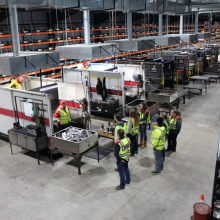The economic contributions of New Americans in Minnesota

By Doug Loon
President and CEO
Minnesota Chamber of Commerce
This week, the Minnesota Chamber held its annual Workforce Summit, where we had a terrific turnout and important discussions about the future of our state’s workforce. A key highlight was the release of a new report—the first in a series—analyzing the economic contributions of new Americans in Minnesota.
You might be wondering, why is the Minnesota Chamber talking about immigration? Simply put, we need more people and skilled workers to move to Minnesota. A growing economy depends on a growing population, and the numbers show that immigration plays a critical role in sustaining our workforce and economic prosperity. To break it all down, I talked with Sean O’Neil, the Chamber’s Director of Economic Development and Research, who led this report. See our full conversation below:
Doug Loon: Sean, give us the key takeaways from the report.
Sean O’Neil: Thanks, Doug. The Chamber has been studying immigration and its impact on Minnesota’s economy for over 15 years. Our research shows that new Americans contribute significantly—not only as workers but also as entrepreneurs, consumers, taxpayers, and connections to the global economy.
The data is staggering: 94% of Minnesota’s net population growth this decade has come from immigration. This is somewhat unprecedented, with immigration now driving overall population growth in the state. It also accounts for about 60% of total job and labor force growth so far this decade. Over time, immigration is becoming a larger share of our economy and workforce.
DL: Let’s take a step back and discuss Minnesota’s broader workforce and population challenges. As I mentioned earlier, you can’t have a growing economy without a growing workforce. While international migration has been a key factor, what do the numbers tell us about domestic migration?
SO: Good question. Population growth comes from three main sources: natural change (births minus deaths), domestic migration, and international migration. Over the past 24 years, Minnesota has experienced negative net domestic migration in 20 of those years, meaning we’ve lost more people to other states than we’ve gained. That trend has been a major headwind for our population growth.
At the same time, birth rates in Minnesota have declined, further slowing natural population growth. This leaves immigration as the key lever for sustaining healthy growth in our workforce and overall economy.
DL: It’s clear that immigration is essential to our state’s future. What are some of the unique contributions that new Americans bring to Minnesota’s economy, particularly in business, innovation, and high-skilled industries?
SO: This is where the story gets even more interesting. Our research found that not only are new Americans making up a larger share of our workforce, but their economic impact is evolving. Over time, Minnesota’s foreign-born population has become more highly educated and skilled, taking on high-demand jobs in technology, healthcare, and other critical sectors.
Additionally, entrepreneurship rates among new Americans have been rising steadily. Many are launching businesses, creating jobs, and driving innovation. This increased participation in high-productivity industries is accelerating Minnesota’s economic growth.
This report is an important product of two Chamber initiatives—our Grow Minnesota! program and the Minnesota Chamber Foundation. If you want to dive deeper, I encourage you to visit our website at mnchamber.com and check out the Workforce Summit materials.
As we plan for the future, we must consider all the factors that contribute to a strong economy. The data is clear: new Americans are a key ingredient in Minnesota’s continued economic success.
Thank you for your continued support of the Minnesota Chamber and Chamber Foundation, who puts out these crucial economic reports. You can hear more conversations like this on future Minnesota Business Podcast episodes.



